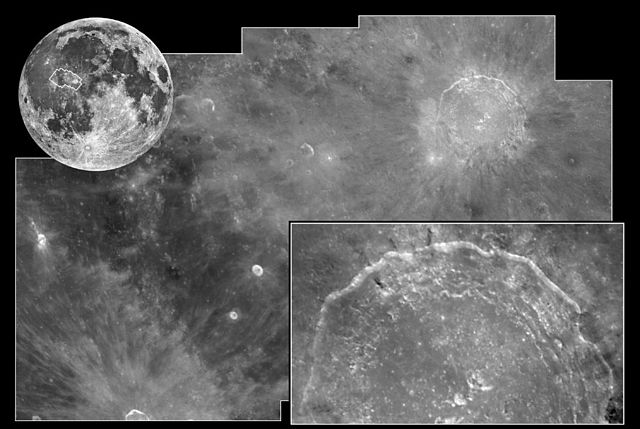 |
This is a file from the Wikimedia Commons. Information from its description page there is shown below.
Commons is a freely licensed media file repository. You can help.
|
Summary
| Description |
HUBBLE SHOOTS THE MOON in a change of venue from peering at the distant universe, NASA's Hubble Space Telescope has taken a look at Earth's closest neighbor in space, the Moon. Hubble was aimed at one of the Moon's most dramatic and photogenic targets, the 58 mile-wide (93 km) impact crater Copernicus. The image was taken while the Space Telescope Imaging Spectrograph(STIS) was aimed at a different part of the moon to measure the colors of sunlight reflected off the Moon. Hubble cannot look at the Sun directly and so must use reflected light to make measurements of the Sun's spectrum. Once calibrated by measuring the Sun's spectrum, the STIS can be used to study how the planets both absorb and reflect sunlight.(upper left)The Moon is so close to Earth that Hubble would need to take a mosaic of 130 pictures to cover the entire disk. This ground-based picture from Lick Observatory shows the area covered in Hubble's photomosaic with the WideField Planetary Camera 2..(centre)Hubble's crisp bird's-eye view clearly shows the ray pattern of bright dust ejected out of the crater over one billion years ago, when an asteroid larger than a mile across slammed into the Moon. Hubble can resolve features as small as 600 feet across in the terraced walls of the crater, and the hummock-like blanket of material blasted out by the meteor impact.(lower right)A close-up view of Copernicus' terraced walls. Hubble can resolve features as small as 280 feet across. |
| Date |
21 May 1999 |
| Source |
http://photojournal.jpl.nasa.gov/catalog/PIA01541 |
| Author |
Space Telescope Science Institute |
Licensing
| Public domainPublic domainfalsefalse |
 |
This file is in the public domain because it was solely created by NASA. NASA copyright policy states that "NASA material is not protected by copyright unless noted". (See Template:PD-USGov, NASA copyright policy page or JPL Image Use Policy.) |
|
|
|
Warnings:
- Use of NASA logos, insignia and emblems are restricted per US law 14 CFR 1221.
- The NASA website hosts a large number of images from the Soviet/ Russian space agency, and other non-American space agencies. These are not necessarily in the public domain.
- Materials based on Hubble Space Telescope data may be copyrighted if they are not explicitly produced by the STScI. See also {{ PD-Hubble}} and {{ Cc-Hubble}}.
- The SOHO (ESA & NASA) joint project implies that all materials created by its probe are copyrighted and require permission for commercial non-educational use.
- Images featured on the Astronomy Picture of the Day (APOD) web site may be copyrighted.
|
File usage
The following pages on Schools Wikipedia link to this image (list may be incomplete):
All five editions of Schools Wikipedia were compiled by SOS Children. The world's largest orphan charity, SOS Childrens Villages brings a better life to more than 2 million people in 133 countries around the globe. Help another child by taking out a sponsorship.





